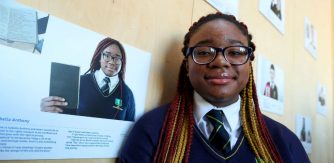Blog 3 – Dan Colley, Dramaturg & Director of Collapsing Horse Theatre


Dan Colley is a director, dramaturg and programmer from Dublin. As Director of Collapsing Horse Theatre he has directed The Water Orchard (with Eoghan Quinn, co-produced by Project Arts Centre) The Aeneid, Bears in Space, Conor: at the end of the Universe, Human Child, Distance from the Event and Monster/Clock. With Collapsing Horse, Dan is Theatre Artist in Residence in Draíocht and co-Artistic Director of Kilkenny Cat Laughs Festival. As a dramaturg Dan has worked with Macnas, Dublin Fringe Festival, WillFredd and Sugarglass Theatre among others. Dan has a degree in English and Philosophy from NUI Galway and studied Youth Theatre Facilitation with Youth Theatre Ireland. Dan was a recipient of the Next Generation Bursary in 2016.
Blog post 3: Rights Museum
In my last blog post I detailed “Phase 1” of the process in which I facilitated drama and storytelling workshops with the 2nd year Art students at Larkin Community College, and the work-in-progress of the Rights Museum project which we presented in Croke Park for the OCO’s UNCRC25 Launch.
Although the presentation in Croke Park was supposed to be a “work-in-progress”, any readers who have done works-in-progress themselves will know there’s an inevitable sense of completion that sets in afterwards. Our challenge for “Phase 2” of the Rights Museum project was finding something new in executing the same idea. At the same time, the Art teachers Declan Quinn and Siobhán Mackenzie (who had been an essential energetic and creative force through the process from the beginning) started to feel the gravitational pull of the curriculum on their time, and thought that to continue with the process would be consume more time than they could afford to give. So, it was with some difficulty that we decided to draw a line under the phase 1 with the second year art students. This, I’m sure is a challenge and a decision many educators reading this will understand.
In order to continue, Máire O’Higgins, Deputy Principal and coordinator of artistic partnerships, needed to find an enthusiastic teacher and a group students who could benefit from the work. This she found in abundance in Emma O’Reilly and her first year CSPE class.
The task now was to recreate the process of phase one with a new group. This time, given that they were a CSPE class, we decided to find our way in through the UNCRC. Emma O’Reilly gave an introduction class to the United Nations Charter on the Rights of the Child, supported by me and Máire O’Higgins. Human Rights is one of the core pillar concepts of their CSPE course which they would normally cover in second year, so there was a curricular link there.
In our next session we asked the students to pick what they considered to be the most essential article in the UNCRC and to say why. We found their answers tended to cluster around the articles relating to family (and this was a theme we saw bare out in the objects they chose for the museum later). As the students told us which articles they thought were essential , my job as facilitator was to foment debate and dissent.
I used an exercise called “The Continuum” in which we cleared away the tables and chairs, nominated one end of the room to be “strongly agree” and the other side to be “strongly disagree” with “unsure” in the middle. When I said a statement, the students had to place themselves in the room, depending on how they felt about the statement. So, for example I might say “’Article 24; you have the right to healthcare’ is the most essential right” and the students would place themselves in the room depending on whether they agreed or strongly disagreed or somewhere in the middle. Then I would call on people who had taken the most extreme positions to say why. As they listened to the conversation and opposing points, students were encouraged to change their positions in the room as they changed their minds.
In this way, the students learned, from each other, the importance of their rights through the personal anecdotes they shared; they learned about their rights in reality. Choosing extreme statements to polarise opinion at the start and then allowing them to tease out the nuances among themselves.
In my next, and final, blog post I’ll describe how we applied this knowledge to museum curation; how one can tell stories and create meaning through selecting and placing objects. I’ll describe the process of working with the National Museum of Ireland, the launch of our completed Rights Museum exhibition in the National Museum at Collins Barracks and the Education Pack being commissioned by the OCO based on the Rights Museum.


